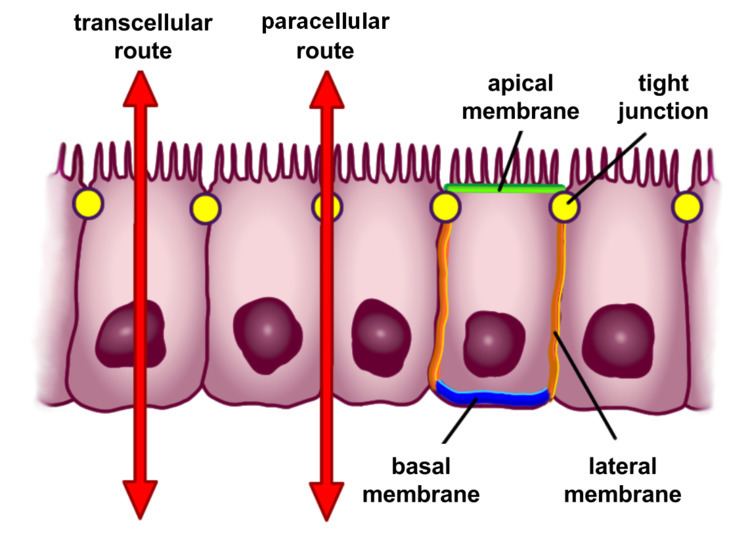 | ||
Intestinal permeability is a term describing the control of material passing from inside the gastrointestinal tract through the cells lining the gut wall, into the rest of the body. The intestine normally exhibits some permeability, which allows nutrients to pass through the gut, while also maintaining a barrier function to keep potentially harmful substances (such as antigens) from leaving the intestine and migrating to the body more widely. In a healthy human intestine, small particles (< 4 Å in radius) can migrate through tight junction claudin pore pathways, and particles up to 10-15 Å (3.5 kDa) can transit through the paracellular space uptake route.
Contents
Physiology
The barrier formed by the intestinal epithelium separates the external environment (the contents of the intestinal lumen) from the body and is the most extensive and important mucosal surface of body. The intestinal epithelium is composed of a single layer of cells and serves two crucial functions. First, it acts as a barrier, preventing the entry of harmful substances such as foreign antigens, toxins and microorganisms. Second, it acts as a selective filter which facilitates the uptake of dietary nutrients, electrolytes, water and various other beneficial substances from the intestinal lumen. Selective permeability is mediated via two major routes:
Modulation
One way in which intestinal permeability is modulated is via CXCR3 receptors in cells in the intestinal epithelium, which respond to zonulin. Gliadin (a glycoprotein present in wheat) activates zonulin signaling irrespective of the genetic expression of autoimmunity, leading to increased intestinal permeability to macromolecules. Bacterial pathogens such as cholera, select enteric viruses, and parasites modulate intestinal tight junction structure and function, and these effects may contribute to the development of chronic intestinal disorders. Stress and infections also seem to cause perturbations in intestinal permeability.
Clinical significance
The opening of intercellular tight junctions (increased intestinal permeability) can allow passage of microbes, microbial products, and foreign antigens into the mucosa and the body proper. This can result in activation of the immune system and secretion of inflammatory mediators.
Increased intestinal permeability is a factor in several diseases, such as Crohn's disease, celiac disease, type 1 diabetes, type 2 diabetes, rheumatoid arthritis, spondyloarthropathies, inflammatory bowel disease, irritable bowel syndrome, schizophrenia, certain types of cancer, obesity, fatty liver, atopy and allergic diseases, among others. In the majority of cases, increased permeability develops prior to disease, but the cause–effect relationship between increased intestinal permeability in most of these diseases is not clear.
A well studied model is celiac disease, in which increased intestinal permeability appears secondary to the abnormal immune reaction induced by gluten and allows fragments of gliadin protein to get past the intestinal epithelium, triggering an immune response at the intestinal submucosa level that leads to diverse gastrointestinal or extra-gastrointestinal symptoms. Other environmental triggers may contribute to alter permeability in celiac disease, as intestinal infections and iron deficiency. Once established, this increase of permeability might self-sustain the inflammatory immune responses and perpetuate a vicious circle. Eliminating gluten from the diet leads to normalization of intestinal permeability and the autoimmune process shuts off.
Research directions
In normal physiology, glutamine plays a key role in signalling in enterocytes that are part of the intestinal barrier, but it is not clear if supplementing the diet with glutamine is helpful in conditions where there is increased intestinal permeability.
Prebiotics and certain probiotics such as Escherichia coli Nissle 1917 have also been found to reduce increased intestinal permeability.
Larazotide acetate (previously known as AT-1001) is a zonulin receptor antagonist that has been probed in clinical trials. It seems to be a drug candidate for use in conjunction with a gluten-free diet in people with celiac disease, with the aim to reduce the intestinal permeability caused by gluten and its passage through the epithelium, and therefore mitigating the resulting cascade of immune reactions.
Leaky gut syndrome
A proposed medical condition called leaky gut syndrome has been popularized by some health practitioners, mainly of alternative medicine and nutritionists, which theorizes that restoring normal functioning of the gut wall can cure many systemic health conditions. There is little evidence to support this theory and that so-called "treatments" for "leaky gut syndrome"—such as nutritional supplements, as those containing probiotics); herbal remedies; gluten-free foods; and low FODMAP, low sugar, or antifungal diets—have any beneficial effect for most of the conditions they are claimed to help.
